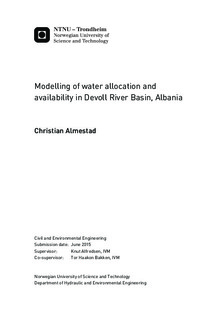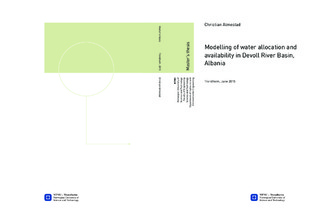| dc.description.abstract | ABSTRACT
Albania is experiencing a significant increase in energy demands and insufficient generating capacities. Although Albania has a large potential for hydropower development, only 35% has been utilized so far. The current energy system is highly dependent on fossil fuels and approximately 40% of the energy consumed is imported. Development of renewable energy is one the priorities of the Albanian Government, with hydropower as the main contributor. In 2013, Statkraft AS acquired all shares of the currently developing Devoll Hydropower Project, which comprises two power plants with an expected annual production of 729 GWh. The power plants will be located along Devoll River in the southeastern part of Albania, and will increase the Albanian power production with 17%. Agriculture is the main source of income in the Devoll River Basin and irrigation is of vital importance to the farmers. The construction of the hydropower scheme may lead to conflicts in interests between the power plants and the irrigation schemes.
The purpose of this thesis is to analyze how climate change and irrigation will affect the runoff in the Devoll River, as well as the annual production at the power plants. A hydrologic model of the river basin was developed using the Water Evaluation and Planning (WEAP) software tool. The model includes nine sub-basins and 26 irrigation schemes. PBIAS, NSE and RSR was used to evaluate the calibration performance. The model performs very good with respect to PBIAS, and satisfactory with respect to NSE and RSR. Reservoir evaporation was calculated manually with the Penman-Monteith equation to further assess the water footprint of the power plants. Three scenarios of upstream irrigation was created with the IPCC RCP4.5 climate projection as foundation. This projection assumes an average increase in temperature of 2.4°C, and a reduction in precipitation of 10% from October to March, and 20% from April to September. The model has two major weaknesses: it does not consider groundwater and the hydropower function is too simple for any realistic simulations.
The main finding is that the Devoll River is not strongly affected by climate change. By 2100, the runoff at the outlet may be reduced with 14% compared to 1980-1985. The power production may be reduced with 43.9% due to this reduction in runoff. The upstream irrigation do not affect the global water balance significantly, as most of the demands are unserviceable. If the schemes are rehabilitated and all demands become serviceable, the irrigation demands alone may cause a reduction in the annual runoff of 17.5%. Based on net evaporation, the combined water footprint of the reservoirs is 1.7 m3/MWh in 2100. Construction of the Banja HPP may provide great supply security for the irrigation schemes downstream of the dam. | |

